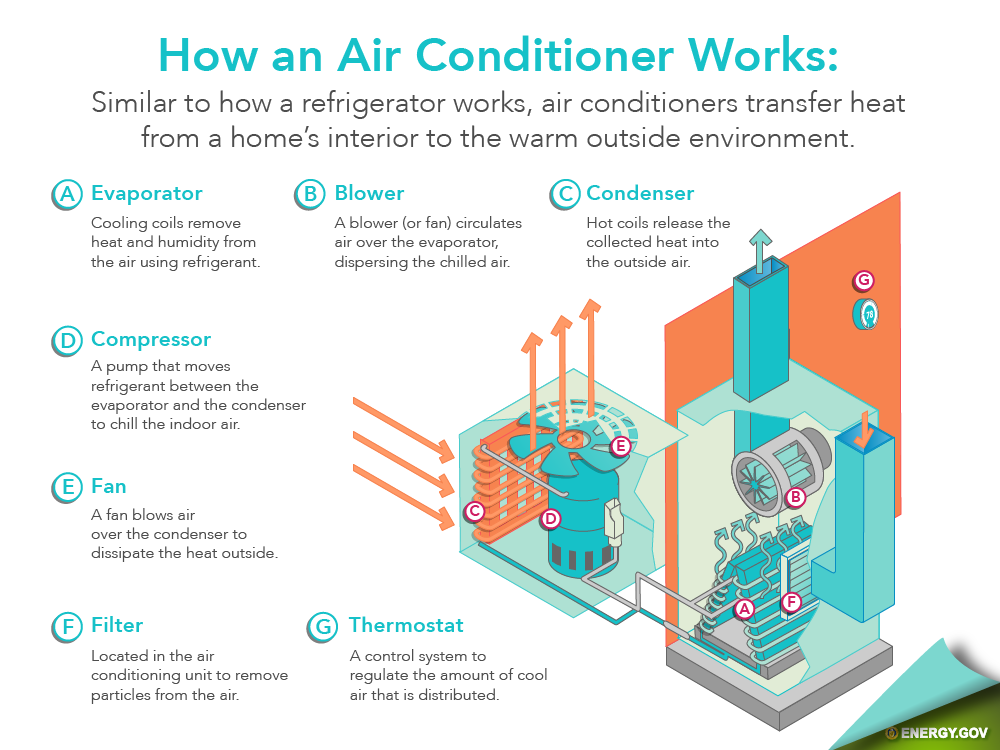How Does Central Air Work?
Central air conditioning refers to a comprehensive system that features several components:
A thermostat for controlling system operation: It signals central AC systems to cycle on and off once the home reaches a set temperature.
An outdoor unit that features a condenser coil, fan, and a compressor
An indoor unit that features an evaporator coil and a blower fan (air handler) to circulate the cooled air
A network of copper tubing that enables refrigerant to flow freely between the indoor and outdoor units
An expansion valve to regulate the amount of refrigerant that flows through the evaporator coil
Ductwork throughout the home allows the air to circulate from the indoor unit to all the living space areas and back into the indoor unit.
In basic terms, air conditioning involves two simultaneous actions — one inside the home and one outside the home.
The Cold Side — Inside the Home
Warm indoor air blows across a cold coil full of refrigerant. This cools the air inside the home. The heat from the indoor air absorbs into the refrigerant returns to gas form from liquid. The cooled air is distributed into the house through the ductwork.
The Hot Side — Outside the Home
In the outdoor unit, the refrigerant gas is compressed before it enters the coil. As the refrigerant turns back into a liquid, warm air is released outside. The fan pulls in the outdoor air and rejects the heat absorbed from the home.
This results in a continuous cycle of heat and humidity leaving the indoor air, cool air coming back into the home, with heat and humidity exiting.

The thermostat monitors and controls the indoor air temperature. The cooling process begins when the thermostat determines that the temperature needs to be lowered. It signals the air conditioning system both inside and outside to start running.
The indoor unit's fan pulls hot air from the inside of the house through the return ducts. The air passes through filters, where lint, dust, debris, and other airborne particles are collected. The filtered indoor air passes over the cold evaporator coil, converting the liquid inside the coil into gas. The indoor unit's blower fan pumps the cooled air back into the home.
The refrigerant gas escapes the home through the copper tubing, at which point it passes into the outdoor unit's compressor. This process compresses the gas and sends the refrigerant to the outdoor unit's condenser coil. The fan pulls outdoor air through the condenser, which allows the air to absorb heat from the home and push it back outside.
The process converts the refrigerant back to liquid, where it goes through the copper coil back to the indoor unit. Before it makes it to the evaporator coil, it passes through an expansion device to regulate the amount that enters the evaporator coil. And the cycle repeats.
Types of Air Conditioners
There are three main types of air conditioners - and though they have their differences, they are all designed to cool the interior of the area where they are used.
Split System Air Conditioner
This is the most common type of central air conditioner. It's what most people with central air have. The indoor unit is usually a furnace or fan coil. The outdoor unit houses the condenser coil and the compressor.
WIth split-system air conditioners, there are a variety of options to choose from. At the lower end of the spectrum, you can get a basic single-stage AC system. Mid-tier systems are efficient. The most energy-efficient and quietest options are multi-stage systems. Using a split system air conditioner provides consistent, reliable temperature control for an entire home. The system also uses air filters inside the indoor air handler to help keep your air clean while it cools it.
Packaged Air Conditioner
AC system is an all-in-one solution instead of an indoor, and outdoor everything is housed in a single unit. This is a good option for areas where there is not enough space in an attic or closet for the indoor unit. It's also a good option where rooftop installations are preferred. The package system still pulls warm from the air ducts into the evaporator coil, passes it over a coil of refrigerant, and then blows it back into the home through the ducts.
A window air conditioner is a type of packaged air conditioner since everything is housed in a single unit.
Ductless Air Conditioner
A ductless air conditioner isn't considered a central air system because it delivers cooling to specific and targeted areas within a building. Installation is generally less invasive because there is no ductwork required.
Instead, there's a single outdoor unit and multiple indoor AC units. These indoor units can be installed in a ceiling, on a floor, or a wall. Only the rooms where indoor units are installed can be cooled. Some ductless systems do not allow for multiple indoor units. There is no central temperature control, and you must adjust each room independently. This means it easier for you to cool a bedroom while keeping the rest of the home warmer.
No matter what kind of central air system you have, keeping your filters clean is essential. The more dirt and debris the filter pulls from the air, the harder the HVAC system will have to work to cool your home. And the harder it works, the more energy you'll consume - and the sooner you'll have to repair or replace.
At Filter King, we have a variety of filter sizes to meet your needs. And we offer custom filters, too. And to keep you from forgetting to change your filter, we have a filter subscription service with automatic delivery on the schedule you choose.

